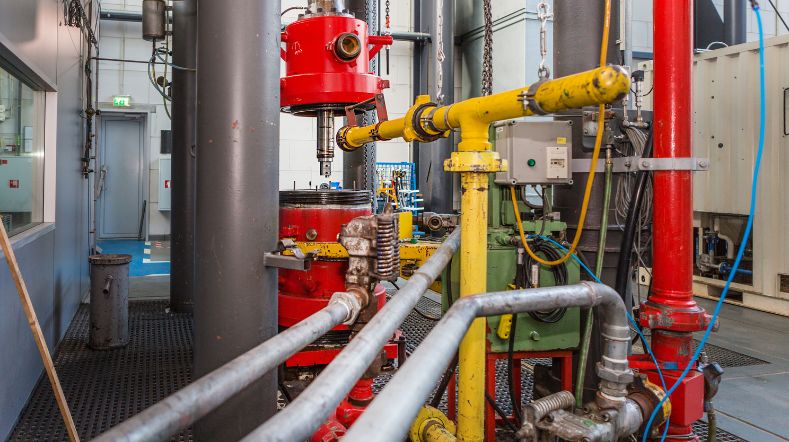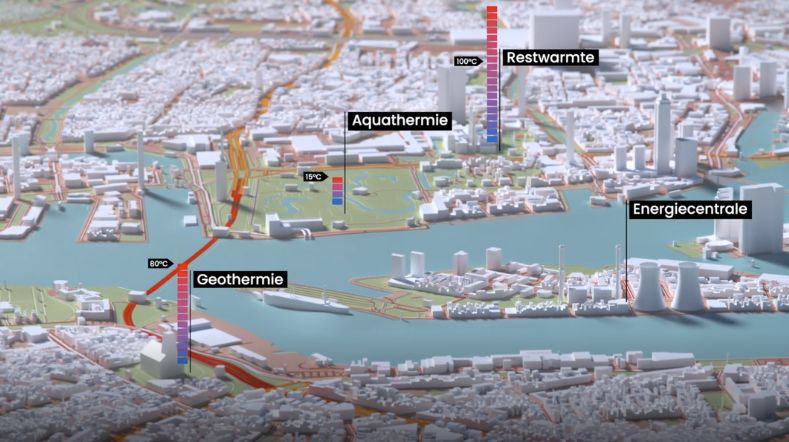
Further growth in geothermal energy production in 2024
In the Dutch energy transition, geothermal energy plays a significant role in the sustainability of heat supply to greenhouse horticulture and the built environment. The Dutch government aims for an annual geothermal production of 15 petajoules (PJ) by 2030 and 80 PJ by 2050. TNO analysed the geothermal production in 2024 and found that the growth in production compared to 2023 has increased. A production forecast shows that the ambition of 15 PJ by 2030 is likely to be achieved. However, the ambition to produce 80 PJ of geothermal energy in the Netherlands by 2050 seems difficult to achieve.
TNO annually publishes the report "Natural Resources and Geothermal Energy in the Netherlands" on behalf of the Ministry of Climate and Green Growth. This report includes data on the developments around geothermal energy: the progress of new wells, permits, and production figures. It concerns geothermal energy that comes from more than 500 meters below the earth's surface.
Ambition for 2030 achievable, ambition for 2050 difficult to realise
In addition to this annual report, TNO published a report with an analysis of geothermal production data and several production forecasts. The main findings are:
- In 2024, 7.49 PJ of geothermal energy was produced, an increase of over 10% compared to 2023. The annual geothermal production shows a recovery compared to the slight increase in 2023, which was only 0.5%.
- The limited growth in 2023 was mainly related to installations being out of operation due to maintenance.
- The production forecast shows that the government's ambition to produce 15 PJ of geothermal energy by 2030 can be achieved.
- The production forecast also shows that the ambition of 80 PJ by 2050 is difficult to achieve.
- In the long term, the uncertainty about the realization of new geothermal production installations is high, due to several bottlenecks such as grid congestion, nitrogen deposition limits, the number of required wells per year, and the integration of geothermal energy production for the built environment.
- High investment costs remain a bottleneck for accelerating the realization of new geothermal production. The Sustainable Energy Production and Climate Transition Incentive Scheme (SDE++) is important for the realization of new geothermal projects, but the future of the SDE++ is uncertain.
- Additional production forecasts demonstrate that the (temporary) loss or halving of the SDE++ subsidy budget can delay the development of geothermal production in the Netherlands.
Full report
Do you want to read the entire analysis? Download the report 'Geothermal energy in the Netherlands (in Dutch) (pdf)'.
Growth in geothermal production recovers
In 2024, 23 operational installations collectively produced 7.49 PJ of geothermal energy, over 10% more than in 2023. This shows a recovery in the annual growth of geothermal production, which was only 0.5% in 2023 compared to 2022. This limited growth was mainly due to multiple installations being temporarily out of operation for maintenance in 2023.
The significant growth in 2024 is primarily due to more operational hours per installation on average. Additionally, three new geothermal installations became operational in 2024, although they contributed only slightly to the total production in 2024.

Geothermal production forecast: 2030 ambition achievable
The Dutch government aims to produce 15 PJ of geothermal energy by 2030 and 80 PJ by 2050. TNO has developed a new production forecast, in which the continuation of current policies is assumed. Geothermal projects are divided into six groups based on their maturity, each with its own uncertainties regarding expected energy production, power and operational hours. The forecast shows that the 15 PJ production target for 2030 is likely to be achieved.

The P-values indicate the statistical probability of achieving the given production volume. P90: 90% of all results are greater than the mentioned value, P50: 50% of all results exceed the given value, P10: only 10% of results are higher than the given value. The size of the difference between the P90 and P10 values indicates how certain the P50 values are. The larger the difference between the P90 and P10 values, the greater the uncertainty is.
Chance of achieving the 2050 ambition is small
The ambition to produce 80 PJ of geothermal energy by 2050 seems difficult to achieve (only in the most optimistic forecast is this ambition met). The long-term uncertainty in geothermal production is high, particularly regarding the realization pace of new geothermal installations.
This is due to several bottlenecks, including drilling efforts, grid congestion, nitrogen deposition limits, and the challenging integration of geothermal energy production into the heat supply for the built environment. These bottlenecks are also discussed in the 2024 Whitepaper. The expected geothermal powers and operational hours are also difficult to predict.
Production forecasts SDE++
Geothermal projects have high investment costs and therefore a high project risk. The Sustainable Energy Production and Climate Transition Incentive Scheme (SDE++) reduces this risk by shortening the payback period of the investment. The SDE++ is essential for the realization of geothermal projects, but its future is uncertain.
To understand the potential impact of the (temporary) loss or halving of the SDE++ budget on the realization of new projects, six additional production forecasts were calculated. These are compared with the aforementioned production forecast: the Base Case Scenario. The additional forecasts do not include the possibility that for instance the SDE++ is (partially) replaced by a so-called CAPEX-subsidy, which is currently favored by Dutch geothermal sector.

The additional forecasts show that the realization of new installations, and thus further growth in annual geothermal production, can experience significant delays. As a result, the Dutch government’s 2050 ambition becomes even more difficult to achieve.
Get inspired
TNO–SodM–NIOZ: ‘Methane emissions in the North Sea often linked to shallow natural gas’


Heat


Geothermal energy: sustainable heat from the subsurface


Smarter storage: how TNO optimises thermal energy storage


Heat system integration: aligning all the pieces


